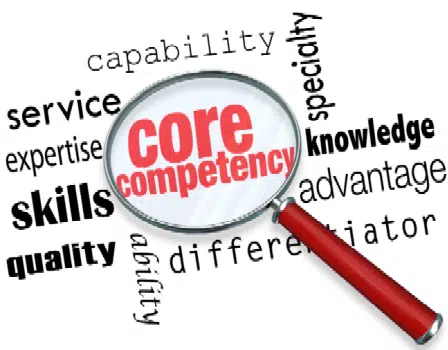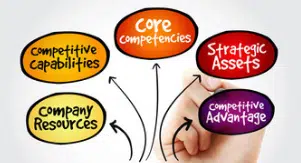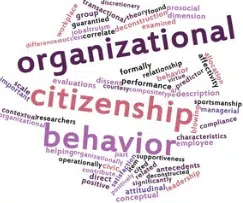
What is a Core Competency?
A Core Competency is the combination of knowledge, skills and their application that is vital to the success of an organization. It can be defined at the organization level (Hamel & Prahalad) and/or at the individual level.
Core Competencies of the Organization

Examples include
- Apple’s ability to design, market and produce user friendly devices with visual and tactile appeal.
- Singapore Airline’s customer centric service bundling of aircraft comfort, quality in-flight service, attentive crew.
- Avon cosmetics direct sales process
- Hubspot’s inbound marketing system
Identifying the core competencies of your organization is a fundamental step in strategic management. Once identified you can move on to identify the mix of specific core, leadership and technical competencies that the workforce will need to deliver on this.
The concept of “Core Competency” comes from management professors Gary Hamel & C.K. Prahalad. They introduced the idea in their 1990 article for the Harvard Business Review – “The Core Competence of the Organisation.” They wrote:
A company’s competitiveness derives from its core competencies and core products (the tangible results of core competencies).
Core competence is the collective learning in the organization, especially the capacity to coordinate diverse production skills and integrate streams of technologies
… core competencies, … meet these three requirements: they provide potential access to a wide variety of markets, make a contribution to the customer benefits of the product, and are difficult for competitors to imitate.
2 kinds of Core Competencies for Individuals
Core competencies are cross role capabilities that communicate how work should be done across your organization (e.g., communication, teamwork, ethics, customer focus). Unlike technical competencies, core competencies can apply to everyone, or to groups of staff. Each one should include a short definition and observable, measurable indicators. You can start simple or have different competency standards statements for different levels of seniority.
1. Values-based core competencies (organizational citizenship behaviors)
From the Organizational Psychology literature comes the concept of Organizational Citizenship Behaviour. Behaviour that goes beyond the requirements of an individual’s job description – sometimes termed “extra-role’ behaviours.
“performance that supports the social and psychological environment in which task performance takes place” (Organ, D. W. (1997). Organizational citizenship behavior: It’s construct clean-up time. Human Performance, 10, p. 95).
Purpose: express how we work together; anchor culture and ethics across every role.

Organizational Citizenship Behaviour includes elements of conscientiousness, altruism and peacekeeping, courtesy, civic spirit and sportsmanship.
The principles of reciprocity and team dynamics are the foundation for many of these behaviours.
- People who display conscientiousness will turn up on time, follow rules, attend to detail, see things through and go the extra mile.
- People who display altruistic behaviours will share their expertise, assist others in their work, co-operate, provide emotional support, and try to solve problems involving others.
- Courtesy means positive interpersonal behaviours, being considerate and tactful, good manners and the avoidance of conflict.
- Civic spirit means supporting and promoting, cheer leading the group or organization in its purposes and goals, making suggestions for improvement, keeping up with organizational events, participating in initiatives that are not mandatory, speaking up when needed.
- Sportsmanship reflects the readiness of staff to put up with uncomfortable situations, not complaining.
Organizational citizenship behaviours are supposed to be for the benefit of the organization.
However the motive for their practice at individual level is primarily impression management. Employees want to project a favorable image for performance evaluation and career advancement. Thus organizational citizenship behaviours are potentially a win win situation.
For this reason there has been a great deal of interest in these concepts especially since the beginning of the 21st century.
2. 'Future-of-work' core competencies
In its annual Future of Jobs report, the World Economic lists core competencies that respondents to its survey have identified. In 2025 this is much the same as in the previous few years
- Analytical Thinking
- Resilience
- Flexibility
- Agility
- Leadership
- Social influence
- Creative thinking
- Lifelong Learning
Most agree that now Digital Literacy is also a core competency.
Purpose: enable people to perform in changing contexts, tools, and operating models.
Why the distinction matters
Distinct assessment methods: Values → best in performance management alongside goals. Core Competencies → best in your developmental competency assessments.
No double counting: Culture behaviors shouldn’t compete with role skills in the same assessment; they inform how results are achieved.
Different governance: Culture items change slowly; core competency sets evolve more quickly with technology and strategy.
Manage both vales based competencies and the future of work core competencies with the central competency library and mapping facility.
How to choose core competencies
Values based Core competencies
Values based or citizenship competencies are used to communicate expectations. The behaviours required to deliver on the organization’s Mission and Values – for example “Empathy” in Health and Social Service organizations.
The behavioral competencies that enable people to work effectively as part of a team.
To emphasize their importance they are part of the performance management system. Since they are unlikely to be measured objectively it is better to provide for qualitative (comments) rather than quantitative feedback (ratings) per competency, with just an overall rating.

The list you choose from will include Values or behavior based competencies such as:
- Interpersonal skills
- Team work
- Building Relationships
- Collaboration
- Service
- Business Acumen
- Supporting the Organization
- Leadership
- Developing People
- Diversity/Cultural Competency
Choose 3-5 competencies that reflect the culture you want to shape, develop a maximum of 4 short descriptive statements for each. Validate with managers and a small employee panel.
Future of work core competencies
Start from strategy or your organizational core competence if you have defined one.
Pick up to 6 core competencies that will definitely make a difference across job families.
Create a number of indicators for each – you can start simple or define different standards statements for different levels of seniority. Preferably a maximum of 6 statements per level per competency.
Validate with managers and subject matter experts.
Map these core competencies to job roles – just the most relevant ones per role.
The list you choose from will typically include cognitively based competencies such as;
- Digital Literacy
- Thinking Skills of various types – e.g. Critical thinking, Systems thinking, Mathematical, Analytics
- Problem solving
- Decision Making
- Innovation and Creativity
- Learning Agility
and more advanced communication skills such as Influencing.
FAQs
What’s the difference between values-based core competencies and future-of-work core competencies?
Values-based competencies express how we work together (e.g., empathy, integrity, teamwork). Future-of-work competencies are cross-role skills applied in the job (e.g., analytical thinking, systems thinking, digital/AI fluency). Use the first to shape culture; the second to drive job role performance.
Where should each live in our system?
They will both live in the central competency library. Values-based items will be mapped to performance profiles and automatically appear in performance management processes and analytics. Future-of-work competencies will be mapped to role based profiles, and used in competency assessments that include role specific technical skills. They will be included in skill gap analysis and other competency analytics.
Should values-based competencies have proficiency levels?
No. Keep them as short definitions with 3–5 observable behaviors specific to your context. Levels are for core and technical competencies where scope, independence, risk, and complexity of tasks genuinely change by role or seniority.
How many “core” items should we set?
Typically 3–5 values-based behaviors and 3–6 future-of-work core competencies that apply across job families. Fewer, clearer items drive better adoption and fairer assessment.
Can future-of-work core competencies be universal across all roles?
Not necessarily – to avoid over assessment prioritise the most relevant per job family and role, and the appropriate proficiency level.
How do we align with frameworks like WEF “Future of Jobs”?
Use external lists and frameworks to select your core competencies, then map to job families. Develop or select the standards/indicators by level if you are using proficiency levels. Always adapt them to your context and shared language.
